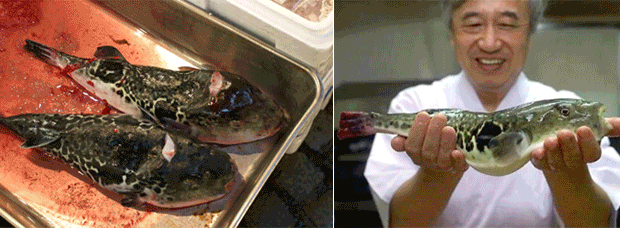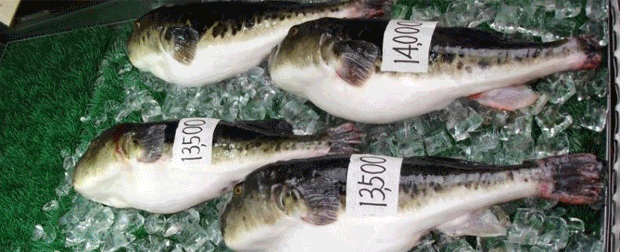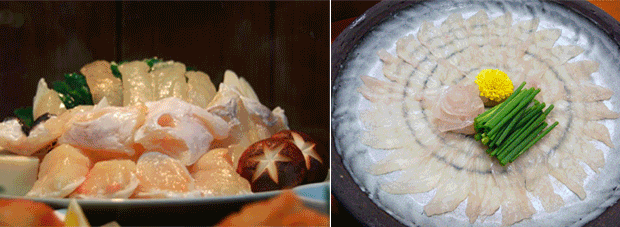|
Fugu is the Japanese name for the most delicate,
dangerous, and expensive fish in the world that, in spite of being
extremely poisonous, continues to be the most stimulating delicacy for
special feasts in Japan. Because of its small fins fugu is a very
sluggish, clumsy, and fatuous-looking fish, which has developed the
peculiar defense mechanism of gulping large amounts of water into its
stomach so as to inflate and turn its chubby body into a menacing spiky
ball twice its normal size, leaving predators unable to swallow it. The
name “fugu” comes from “fuku” (to swell, to blow) as in the Japanese
proverb about people who internalize their worries: “If you don’t speak
(about your problems), your stomach swells.”
This characteristic also led the Japanese to spell fugu with the Chinese
characters for “river pig”, although it is a salt-water fish. Fugu
obviously deserves this name since even in its normal state it is,
indeed, an unsightly, squat, scaleless fish with sneering lips and
glutinous skin. In English it is often referred to as the puffer fish,
blowfish, globefish, balloon fish, swellfish, or “the blowie”.
|
|
 |
|
Puffers have fascinated observers around the world for centuries. The
tomb of the Fifth Dynasty Egyptian Pharaoh Ti who lived around 2700 B.C.
was engraved with the puffer’s bloated image. Ancient Egyptians
apparently also used some puffer species as a ball in a primitive game
of bowls. The highly toxic Red Sea puffer fish is also believed to have
prompted the biblical injunction against eating fish without fins and
scales: “These ye shall eat of all that are in the waters: all that have
fins and scales shall ye eat: And whatsoever hath not fins and scales ye
may not eat; it is unclean unto you” (Deuteronomy14:9-10).
Nowadays fugu cuisine is regulated by rigid laws and it can only be
served by licensed chefs, thus ensuring maximum security for fugu
partakers. In the prefecture of Tokyo, which has one of the most
rigorous programs, training takes from five to seven years, and includes
an apprenticeship and an exam. Prospective puffer chefs learn the
identification of blowfish species, their distinctive anatomy, relative
toxicity of the parts, methods of disemboweling and cleaning,
instructions for preparation, and even first aid procedures. To make the
cooks’ lives more difficult, the ovaries, which, along with the liver,
are the most poisonous parts, are terribly difficult to distinguish from
the milt, which is considered a particularly palatable delicacy. Plus,
there are about 20 popular varieties of fugu to choose from. And, of
course, not all people are eligible for training – color-blind people,
people with poor vision and minors, for instance, are not allowed to
handle puffers.
|
|

|
|
Fugu is served mostly in wintertime in order to avoid increased levels
of toxicity generated as a reproductive defense mechanism. Therefore,
there is a considerable difference in prices over the seasons. Though
many fishermen still catch fugu with hooks and nets, Japan has been
particularly successful in artificial cultivation. Puffers are usually
harvested in spring, in the midst of their spawning season. Then people
cultivate the blowfish in large offshore cages. In these conditions,
fugu is fed upon fresh fish until complete maturation; farmed puffers,
not feeding on plankton, are not as toxic as their free, natural
“peers”.
Fishermen raise the blowies in aquafarms until the price goes up and
start selling fugu at the markets in late autumn. There is also
full-scale farming including artificial insemination. Unlike most fish,
which are dredged up out of the ocean and rushed to the market, where
they perish on a bed of crushed ice in some messy Japanese fish market,
blowfish are sold alive. Therefore, transportation for fugu is
exclusively arranged. The puffers usually get their mouths stitched
shut, as they exhibit aggression towards each other and tend to fight to
death when many of them are confined to small tanks.
|
|

|
|
In addition to the strict control mechanism over issuing licenses to
cooks and restaurants, Tokyo regulations include rules for cleanliness
and preparation, locked storage of the toxic parts, careful reporting on
the amount of fish handled, and the disposal of their internal organs.
The Japanese government has been regulating the disposal of fugu remains
as toxic waste since several homeless people died from eating fugu
remains dumped into garbage bins. Fugu remains must be bagged in two
layers of plastic and kept at home in a special locked box until they
are taken to a special fugu dump, where a fee is paid to have them
destroyed. Considering the speed at which fugu is gaining popularity
around the world and presuming that the species does not consequently
get extinct, you can envision the development of a new industrial branch
in Japan – fugu waste disposal.
In Japan, discerning gourmets pay tremendous prices for a dinner of fugu.
Only the flesh, the skin, the fins, and the milt are generally eaten.
One can order raw sliced meat, sake with strained testes, toasted bone,
dried fillet seasoned with sweet sake, or even pickled ovaries – over
three to four years the ovaries lose their toxicity; besides, pickled
puffer ovaries are so salty that it’s hard to eat much at one time. A
meal of fugu is always ornately presented – the raw meat is sliced
paper-thin and arranged artistically in elaborate rosettes that reveal
the pattern of the dish it is presented on – a bird, a flower or any
other special composition. Whether dipped in the piquant soy, chive and
bitter orange sauce or eaten as chowder, or with rice porridge, the fugu
is said to have a very palatable taste. The large number of fugu
restaurants in Tokyo attests to the fact that its pearly white meat
attracts and makes addicts of many a gourmet. But despite all this, fugu
is the only delicacy which cannot be served to the emperor and his
family!
The puffer fish has over 100 different types worldwide, and they’re all
as poisonous as hell. The skin, the intestines, the eyes, the kidneys,
the ovaries, and, above all, the liver are extremely toxic as they
contain a deadly poison similar to curare for which there is no
currently known antidote. Fugu flesh is considered safe to eat, though,
at times, it can be really toxic too. The amount of poison in a fish
varies according to the species, its sex, the part of its body, the time
of the year, and the place where it was caught. Highest concentrations
occur at spawning time, when the gonads are at their highest toxicity.
The female puffer is considerably more toxic than the male, since she
has some of the deadliest organs: the ovaries.
The actual danger about fugu is that it contains significant amounts of
tetrodotoxin – a substance that is considered to be 1250 times deadlier
than cyanide, shutting down the Central Nervous System in humans.
Tetrodotoxin is found in the blowfish inhabiting the warm waters off
China, Taiwan, and Japan, the Philippines, Mexico, and the Sea of Cortez
off Baja, California. It’s also present in the Australian blue-ringed
octopus and Xanthid crabs, the California newt and the Eastern
salamander.
|
|
 |
|
Tetrodotoxin is estimated to be about 160,000 times more potent than
cocaine! For instance, an average fish of fugu rubripes (torafugu) – the
species most served up as dinner fare – contains enough tetrodotoxin to
kill up to 30 people in a matter of seconds. The estimated lethal dose
for an adult, a mere one to two milligrams, could fit on a pinhead.
Puffer toxin blocks sodium voltage-regulated channels in nerve tissues,
ultimately paralyzing muscles. Since the respiratory system is the most
sensible in such a situation, asphyxia is the ultimate cause of death.
There is currently no proven antidote, perhaps because the toxin has a
molecular structure unlike anything previously known to organic
chemistry. Because of its potency, the toxin is an important tool in
modern neurological research. In very diluted form it is also used as a
painkiller for victims of neuralgia, arthritis and rheumatism.
Fugu is one of the most expensive foods in Japan. It’s not unusual to
find a fugu meal that costs upwards of $100 - $200. As a result, fugu is
prohibitively expensive for most people. Nevertheless, neither the risk
nor the cost can keep it from being immensely popular. The fish are
cultivated on farms and sold at Haedomari Market in Shimonoseki; a
single fish can bring $50 to $140. By the time it reaches your table,
you can be paying upward of $200 for the privilege of surviving the
ordeal.
Yet fugu was increasingly popular. Haedomari Market in Shimonoseki –
Japan’s “Fugu City” – reportedly rakes in over $40 million dollars every
winter from fugu sales alone. At one o’clock in the morning in the
market, a large, high-roofed warehouse on the waterfront where 80% of
Japan’s fugu catch is sold. Even at that hour the fishermen have already
transferred into warehouse tanks hundreds of live fish caught as far
away as Korea. From Shimonoseki, they will be tracked or flown
throughout the country.
What does fugu meat taste like in reality? Some people who’ve tried
puffer dishes describe it as one of the most sublime flavors in the
world. Others, apparently less enthusiastic, or simply more objective,
describe fugu meat as a cross between crunchy and chewy, said by the
Japanese to go “shiko-shiko” in one’s mouth when absolutely fresh.
That’s what some consider the main attraction of the risky meal. But
taste isn’t everything. Many say that fugu is simply addictive!
|
|
 |
|
People who’ve tasted fugu report a funny feeling in their mouths, as if
they had been shot with a dose of dentist’s novocaine. After a licensed
Japanese chef carefully cleans the poisonous puffer, removing the 11
deadly parts of the fish, including the skeleton, skin, ovaries,
intestines, and liver, enough of the neurotoxin remains to produce a
mellow tingling glow, a flush, and a drug rush. Remember, tetrodotoxin
is 160,000 times more potent than cocaine!
Some say the delicate chickeny flavor of the fugu meat is the main
attraction; others insist that fugu testes in a glass of hot sake is the
best aphrodisiac in town; yet others are partial to the warm tingling
and slight numbing of the lips (the pleasant symptoms of systemic
paralysis and ensuing respiratory failure); but, doubtlessly, the
biggest thrill is the striking hubris of the event, the ostentatious
risk-taking that involves so much for so little. Really, who cares what
it tastes like as long as you live to tell the tale?
|